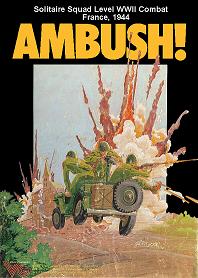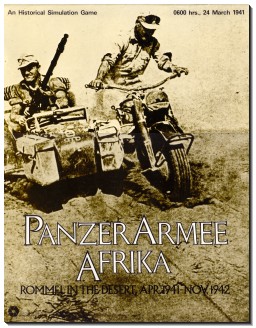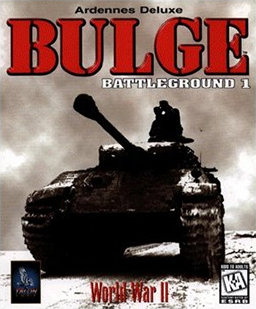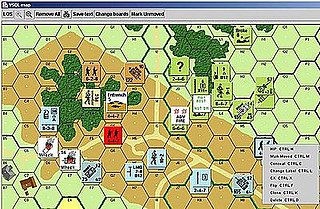This article needs additional citations for verification .(November 2021) |
London's Burning is a board game first published by Avalon Hill in 1995. It was designed by Ben Knight and Mark Simonitch.
This article needs additional citations for verification .(November 2021) |
London's Burning is a board game first published by Avalon Hill in 1995. It was designed by Ben Knight and Mark Simonitch.
London's Burning is a solitaire game of the Battle of Britain.
Ted S. Raicer comments: "London's Burning has a lot more going for it as a wargame than just its subject matter — it is one of the most multifaceted and imaginative game designs in the 50-year history of commercial wargaming. It provides real insight into the historical events it portrays. And, oh yes, it's also a great deal of fun to play." [1]

A wargame is a strategy game in which two or more players command opposing armed forces in a realistic simulation of an armed conflict. Wargaming may be played for recreation, to train military officers in the art of strategic thinking, or to study the nature of potential conflicts. Many wargames recreate specific historic battles, and can cover either whole wars, or any campaigns, battles, or lower-level engagements within them. Many simulate land combat, but there are wargames for naval and air combat as well.

Ambush! is a man-to-man wargame developed by Avalon Hill. It was released under Avalon's Victory Games label and was developed by Eric Lee Smith and John Butterfield. It has been out of print since Avalon Hill was disbanded in 1998.

Miniature wargaming is a form of wargaming in which military units are represented by miniature physical models on a model battlefield. The use of physical models to represent military units is in contrast to other tabletop wargames that use abstract pieces such as counters or blocks, or computer wargames which use virtual models. The primary benefit of using models is aesthetics, though in certain wargames the size and shape of the models can have practical consequences on how the match plays out.

Richthofen's War, subtitled "The Air War 1916–1918", is a board wargame published by Avalon Hill in 1973 that simulates aerial combat during World War I.

The Charles S. Roberts Awards is an annual award for excellence in the historical wargaming hobby. It was named in honor of Charles S. Roberts the "Father of Wargaming" who founded Avalon Hill. The award is informally called a "Charlie" and officially called a "Charles S. Roberts Award". The Wargamer magazine called it "very prestigious". The Award is managed by the Charles S. Roberts Award Committee which has no commercial sponsorship, made up of designers, writers and hobbyists. It is a "people's award" with winners chosen through votes submitted by fans.

PanzerArmee Afrika, subtitled "Rommel in the Desert, April 1941 - November 1942", is a board wargame published by Simulations Publications, Inc. (SPI) in 1973 that simulates the World War II North African Campaign that pitted the Axis forces commanded by Erwin Rommel against Allied forces. The game was revised and republished in 1984 by Avalon Hill.

A man-to-man wargame is a wargame in which units generally represent single individuals or weapons systems, and are rated not only on weaponry but may also be rated on such facets as morale, perception, skill-at-arms, etc. The game is designed so that a knowledge of military tactics, especially at the small unit or squad level, will facilitate successful gameplay. Man-to-man wargames offer an extreme challenge to the designer, as fewer variables or characteristics inherent in the units being simulated are directly quantifiable. Modern commercial board wargaming stayed away from man-to-man subjects for many years, though once the initial attempts were made to address the subject, it has evolved into a popular topic among wargamers.

Alexander the Great is a board wargame first published by Guidon Games in 1971 that simulates the Battle of Arbela in 331 BCE, also known as the Battle of Gaugamela. A revised edition was published by Avalon Hill in 1974. Both editions of the game were notable for having what one critic described as "one of the ugliest maps ever to curse a war game."

Donald F. Featherstone was a British author of more than forty books on wargaming and military history.

Battleground 2: Gettysburg is a 1995 turn-based computer wargame developed and published by TalonSoft. It the second game in the Battleground series.

Battleground: Ardennes is a 1995 computer wargame developed and published by TalonSoft. It the first game in the Battleground series

Panzergruppe Guderian is a board wargame published by Simulations Publications, Inc. in 1976 that simulates the 1941 Battle of Smolensk during World War II.

A computer wargame is a wargame played on a digital device. Descended from board wargaming, it simulates military conflict at the tactical, operational or strategic level. Computer wargames are both sold commercially for recreational use and, in some cases, used for military purposes.
The Society of Ancients (SoA) is an international, non-profit organization based in the UK that aims to promote interest in Ancient & Medieval history and wargaming, covering the periods from 3000BC to 1500AD.

A board wargame is a wargame with a set playing surface or board, as opposed to being played on a computer or in a more free-form playing area as in miniatures games. The modern, commercial wargaming hobby developed in 1954 following the publication and commercial success of Tactics. The board wargaming hobby continues to enjoy a sizeable following, with a number of game publishers and gaming conventions dedicated to the hobby both in the English-speaking world and further afield.

Ted S. Raicer is a game designer who has worked on board games. He became a board wargamer at the age of 12 years and has published more than 10 games based on World War I. Raicer has won many awards in his gaming career.

Tyrone S. Bomba is a prolific American board wargame designer, credited as the designer of over 125 board wargames and game items. Bomba is the recipient of the James F. Dunnigan Award, has been inducted into the Charles Roberts Awards Hall of Fame for his contributions to the wargaming industry, and several of his games have won Charles S. Roberts Awards.

The Pure Wargame, Vol. 1: Death From Above is a 1995 video game developed and published by Quantum Quality Productions for MS-DOS compatible computers.

D-Day: America Invades is a 1995 computer wargame developed by Atomic Games and published by Avalon Hill for IBM PC compatibles. It is the third game in the World at War series, following Operation Crusader and World at War: Stalingrad.